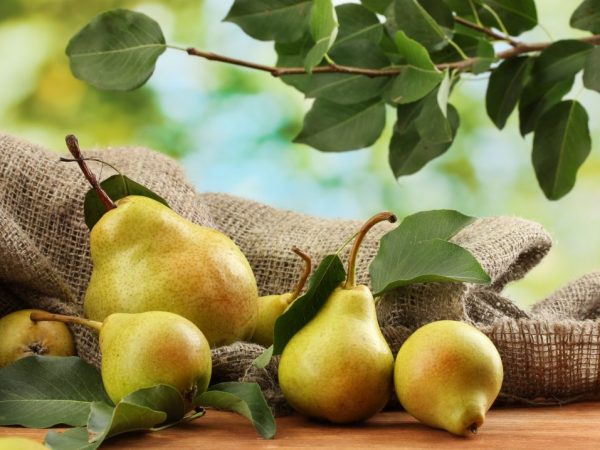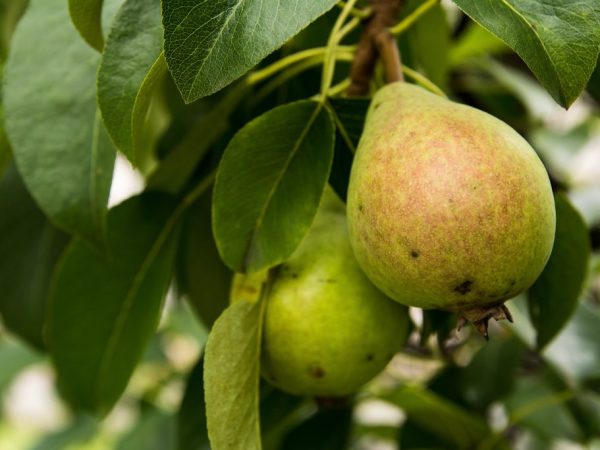Characteristics of the Vernaya pear variety
Pear Vernaya is ideal for central Russia. The hybrid was bred at the end of the 20th century by crossing the Josephine Menchelskaya variety and the interspecific hybrid No. 3. Due to its rich yield and high immunity to diseases, it gained deserved popularity among gardeners.

Characteristics of the Vernaya pear variety
Variety characteristic
Faithful is a fast-growing hybrid. It tolerates freezing well and gives a guaranteed generous harvest. When harvested per hectare, there are up to 30 tons of fragrant fruits.
In central Russia, the harvest is harvested in late September-early October, the main growth of the fruit occurs in September. The variety is absolutely unpretentious and tolerates sharp temperature drops during the period of return frosts in spring.
Description of the tree
Pear trees True irregular shape, medium vigorous, slightly spreading. The tree formation is not quite typical for pears and has a number of characteristic features.
Features of the structure of the tree:
- asymmetrical crown of a drooping shape;
- branches are crooked, skeletal, the arrangement is compact, with a large number of lenticels, growing from the trunk almost at right angles;
- the ends of the branches grow up and to the side;
- the bark at the lower edge of the trunk and main branches is smooth, brown colored;
- young growth of red-brown color, medium-sized;
- the kidneys are smooth, slightly pointed, medium-sized;
- leaves are medium large, dark green, shiny, curved upward, ovoid, with coarse venation and thin petioles;
- flowers are white, medium-sized, five-toothed, fragrant, rounded petals.
The first crop is harvested already 3-4 years after planting the seedling. At first, the fruits are medium-sized, but after a couple of years the pear gives large specimens.
Description of the fetus
The fruits of Vernaya pear are formed on short rosette shoots (ringlets), fruit twigs (up to 15 cm) and a thickened part of the shoots (fruit bags).
Features of the fruit:
- the shape of the fruit is traditional, pear-shaped, slightly beveled;
- medium-large pears (weight about 100-150 g);
- fruits with a shiny skin, under which there is a small number of gray dots;
- fruits are green, by the time of full ripening, a yellow tint is mixed with it;
- the peduncle is short, thick, set obliquely to the axis of the fruit;
- the indentation at the peduncle is practically absent, has a blunt-conical shape;
- the pulp is creamy, very juicy, with a pleasant sweet and sour taste, fine grain, medium density.
Juicy and aromatic pears keep well even in the cold from the moment of picking until the beginning of winter. They are versatile in use. The fruits are used to make desserts, various drinks, jam, marmalade, preserves, liqueurs, wines, alcoholic tinctures, etc. The drinks are aromatic, with a rich fruity taste. Also, the consistency of the pulp allows you to produce marshmallow from Vernaya. The sweetness of the fruit makes it possible not to use sugar in the preparation of this dessert, which makes the product dietary.
Care

The tree needs to be properly cared for
You need to choose the right young seedling.He must be strong and healthy. There should be no broken or dry branches on the plant. It is worth choosing seedlings with a closed root system.
The plant is undemanding to growing conditions, but the gardener should choose the soil wisely. The ideal option would be a fertile drainage soil with a low level of groundwater and sufficient illumination. You need to choose a sunny place that is not blown by the winds.
Tree care is standard:
- shallow loosening of the soil in the near-trunk circle to improve air and water exchange;
- pest control (preventive and curative treatment);
- pruning the crown for its correct formation and rejuvenation, removing dry and damaged branches.
The pear variety Vernaya is frost-resistant, but to support the plant in the cold season, gardeners recommend sprinkling the trunk circle with a mixture of soil and humus. The trunks of young trees during cold weather can be covered with protective material.
Fertilization is recommended annually in the spring. This is done while loosening the trunk circle. With a pitchfork, they carefully dig up the ground with humus or rotted mullein. The plant also needs potash and phosphorus fertilizers. They are introduced during watering, dissolving in water.
Pests and diseases
Trees have immunity against scab, but violations of the rules of care can lead to diseases such as onyliosis (fruit rot), black fungus, powdery mildew, black cancer, leaf rust, cytosporosis (stem rot), root cancer, brown leaf blight. They are dangerous for the harvest and significantly reduce the productivity of the tree.
In addition to these diseases, the plant and crop can be affected by rodents. Sometimes trees are damaged by insect pests: aphids, leaf rollers, pear moths, sapwoods, bark beetles, moths, gall mites, pear itch and weevil (pear flower beetle).
Prevention and treatment activities are carried out from early spring to late autumn:
- Biological - the introduction of organic fertilizers (manure, compost) and the use of herbal decoctions.
- Agrotechnical ones contribute to the growth and development of the tree (the best chosen place for planting, timely pruning of excess and damaged branches, preparation of material for planting).
- Chemical - spraying plants with chemicals for the prevention and treatment of diseases, as well as pest control.
- Physicomechanical - burning of infected branches and fruits.
In addition to the listed diseases and pests, errors in tree care can be the reasons for a decrease in yield, poor growth and development of a plant.
Such errors include an inappropriate planting site, non-compliance with the irrigation regime and pear cultivation technology. The lack of preventive protective treatments and sanitary pruning also affects. Timely prevention and correctly selected treatment help to protect the fruit crop and restore fruiting in the shortest possible time.
Conclusion
According to the description, the Vernaya pear variety has many advantages: early maturity, winter hardiness and keeping quality. Such a pear is an excellent option for planting in central Russia. If stored properly, the fruit can be eaten even in December. The rich harvest is versatile and easy to transport.


